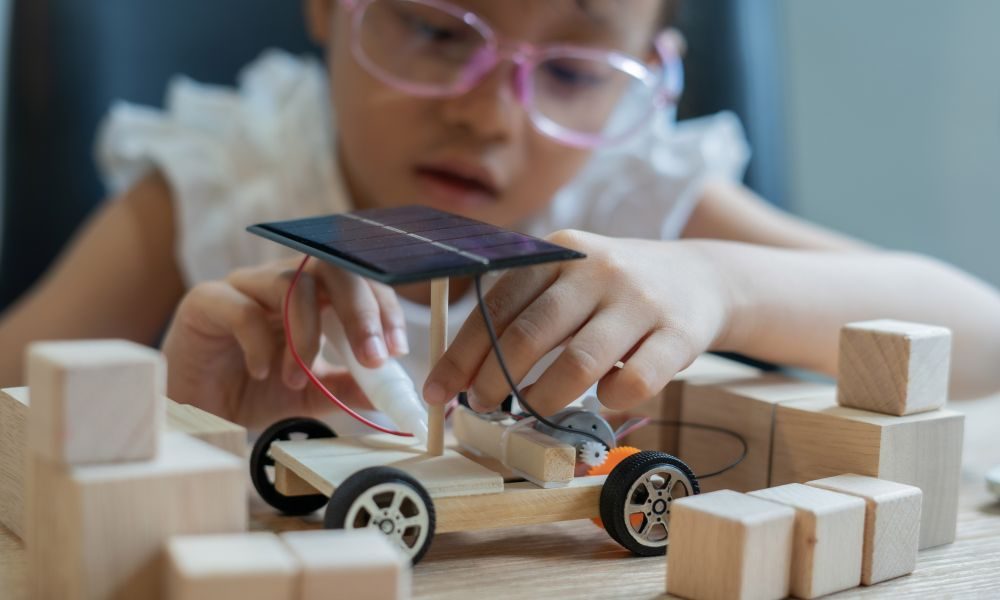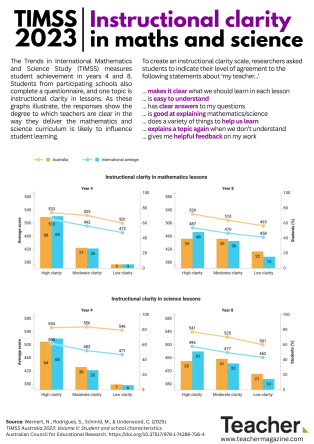The IEA’s Trends in International Mathematics and Science Study (TIMSS) measures student achievement in years 4 and 8. Teachers from participating schools also complete a questionnaire, and one topic is their professional development needs.
Amy Ayres is President of the Science Teachers’ Association of New South Wales (STANSW) and describes herself as a lifelong learner. She is currently the Dean of Teaching and Learning at an independent school on the Northern Beaches of Sydney and is passionate about ‘championing science education that inspires curiosity, critical thinking, and a lifelong love of learning’.
In this expert Q&A, Amy discusses 2 areas of future PD need highlighted in the Australian TIMSS questionnaire that Teacher reported on in a recent infographic (Earp, 2025) – integrating technology into science instruction, and improving students’ critical thinking or inquiry skills – and shares some of the other hot topics for teachers locally.
Tell us a bit about STANSW and how it’s working with teachers to support their professional development.
As a not-for-profit organisation, our committees, council and teacher volunteers are the heart of STANSW, and we’re so lucky to work with passionate educators, partner associations and academics who dedicate their time to sharing knowledge with peers. This year we have over 2,000 members, we’ve worked with over 200 volunteer teachers, academics and scientists to deliver conferences, online professional development workshops, network meetings and courses. Connection and collaboration are what it’s all about! Readers can find out more about what’s happening at the Science Teachers Association of NSW at our website https://stansw.asn.au/. We're excited to be hosting our annual Young Scientist Awards Ceremony this week. Young Scientist recognises and celebrates outstanding science projects from students across New South Wales. The high level of authentic scientific investigation and technological innovation displayed by students is incredible, with student projects tackling real-world issues.
The latest TIMSS data (Wernert et al., 2025) show in Australia, at year 4 the most desired PD topic for teachers was integrating technology into science instruction. What are some of the challenges for practitioners in this area and what are your tips?
At STANSW we host the Primary Teachers’ Network meetings every term, allowing primary teachers to connect with peers, upskill and navigate challenges in the Science and Technology syllabus together. Technology and AI are always hot topics of discussion at both Primary and Secondary meetings. A challenge currently is the confidence of experience due to the fast pace that technology is advancing. Upskilling in new technology takes time, and the allocation of professional learning in this area is limited due to other demands in the Primary curriculum. Another big barrier is cost. As the technology changes so does the need to upgrade, renew or purchase. The ideal classroom would enable this swift adjustment - but whole system change takes time. So, the big barriers are time (of course), large scale systemic management and money.
We have a growing network of primary teachers at STANSW, led by Primary Science specialists and educators passionate about Primary STEM on our council. The Primary Teachers’ Network provides opportunities to collaboratively work together, share knowledge, resources for and guidance for primary science teachers (or primary teachers who want to teach science with technology). We’re excited to be hosting a Primary Forum on 20 March 2026 at Sydney Zoo, where primary teachers can connect and develop the knowledge, understanding and skills needed for effective implementation of the Science and Technology K–6 Syllabus (2024). Here teachers will receive guidance on key support materials, including NESA’s teaching advice, planning tools and professional learning resources, then collaboratively work together to co-design a series of lessons aligned with the new syllabus, that they can take back to classrooms.
We’ll continue our online network sessions each term, because you don’t always have time to go off site to do a day learning on how to use AI or a particular piece of software. But we do have, half an hour, 45 minutes in the car on the way home to listen and join into a network of primary teachers all passionate about science. And hearing them talk about how they've used a piece of software or how they've used a technology in the classroom, I think that's a rich opportunity. It fits into your day, and it gives you top tips and tricks and that anecdotal experience so that you're not walking into something blind. And then also a support network. So, at the end, you can say, ‘I'd like to try this … I’m going to talk it through with other teachers. We share ‘How-tos’, lists of things to try, and then at our conferences, teachers all come together and share their practice. You end up walking away with really useful resources. It's fantastic that Technology in Science is so desirable. Technology has the capacity to amplify learning in the classroom and supports our scientists to collaborate and expediate scientific discovery. Introducing technology in the classroom allows today’s students, or ‘digital natives’ to incorporate skills more fluidly.
And the TIMSS data show ‘improving students’ critical thinking or inquiry skills’ was the most desired topic for PD for year 8 teachers. Again, what are the challenges educators face in this area and what are your tips?
Critical thinking and inquiry skills are essential in the 21st Century. Information is consistently at our door, highly accessible for our children and becoming incessantly so. Knowledge, however, takes times to grow and the phronesis required to function in a complex world requires our children to experience and practice skills which enable them to become healthy individuals in society.
In a recent project STANSW partnered with Global Access Partners (GAP), The Nobel Prize Outreach group, and University of California, Berkeley (UC Berkeley) to present a Critical Thinking course for educators in NSW that linked directly with the curriculum. It was highly successful, and we continue to work in this area to amplify the need for all teachers and students to engage in critical thinking professional learning. I think the beauty of that project is that we offered it for free. There were bite size units of work – my favourite one was the iterative process, problem solving and scientific thinking. There were 4 sessions they did for us. There was another one on decision making: How do you make a decision, a values decision or an evidence-based decision?
We're going to keep working with GAP, the Nobel laureates and Berkeley because I think it has a really important place in our national curriculum, not just New South Wales, but in Australia. Even the TIMSS data tell us that it's broader, so if we can support students with tools, digital tools to help them make decisions, well, that's fantastic. That's such a big bonus. We've given them a shortcut, we've reduced burden.
The resources are available here: https://stansw.asn.au/teaching-resources/
In your state, what have been the hot PD topics for teachers this year? What are you getting lots of requests for?
STANSW supports teachers through peer-to-peer professional development, advocacy, resources and networking and this year brought the implementation phase of the new 7-10 Science Syllabus, so there has been an ongoing need for support with new syllabus implementation resources. We are working with a range of teacher associations to ensure that our students and teachers are well resourced and prepared for the new content, likewise for the new Science and Technology curriculum in Primary.
We have established a working group to support teachers to integrate Aboriginal and Torres Strait Islander perspectives into science teaching, and our resource committees are busy developing resources for new content and focus areas.
We’re also working on multi-disciplined collaborations with teacher associations in other subject areas, to champion STEAM (Science, Technology, Engineering, Arts and Mathematics) and accommodate generalist primary teachers’ needs, to upskill teachers in science alongside other subjects in the primary classroom.
There have been lots of requests for support navigating AI in the classroom, so this has been a focus in our quarterly networking meetings for members and will continue to be.
Our senior teachers are preparing for a new Stage 6 syllabus and have requested insight from scientists in the field. We are busily preparing for the development of new teaching programs and resourcing easy-to-access, modified foundational papers.
Our regional areas have requested accessible support, and so this year we launched a Virtual Forum to support further, without putting additional pressure on budgeting and travel requirements. In addition, we’ve hosted PD days in regional areas, such as the Teachers’ Day at Taronga Western Plains Zoo Dubbo.
Our flagship event, Meet the Markers, continues to be our most popular series, with teachers looking to unpack the most recent HSC Science papers and gain insights from markers, and we also resurrected the student-based HSC lectures to support students in HSC Science exams. The best way to stay up to date is to become a member of STANSW and join the community! Upcoming events can be found at: https://stansw.asn.au/learning-events/
References
Earp, J. (2025, September 19). TIMSS 2023 – Infographic: Future PD needs of science teachers [Infographic]. Teacher magazine. https://www.teachermagazine.com/au_en/articles/timss-2023-infographic-future-pd-needs-of-science-teachers
Wernert, N., Rodrigues, S., Schmid, M., & Underwood, C. (2025). TIMSS Australia 2023: Volume II: Student and school characteristics. Australian Council for Educational Research. https://doi.org/10.37517/978-1-74286-756-4
How confident are you in integrating technology into your science lessons? What are the barriers?
In what ways could peer networks or short, flexible PD sessions (like online forums or Teach Meets) help overcome these barriers?
What strategies have you and your colleagues found effective for building confidence in using new technologies?



